|
When I buy a handmade item, I sometimes think about a book I read awhile back, Small Mediums at Large by Terry Iacuzzo. I won't get into the details of this fascinating memoir of a family of psychics, but I mention it because one of the sisters in the book had the gift of paranormal psycho-metry, meaning she could hold an object and know its story, like its past. Not that I always wonder about an object's past, but I do wonder about the story of how a piece of art, jewelry, painting, or whatever came into being. What's the inspiration behind it? Why did the maker make it? I figure that you might also wonder the same, which is why I want to share the stories of how 5 pieces in our shop came to be. Definitely contact us if you want to know more stories and meanings of other pieces. Everything has its meaning and reason for coming into being. 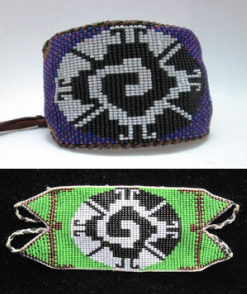 1) The Galactic Butterfly I first saw this pattern called the Galactic Butterfly in 2009 when I read about its symbolism on the Mayan Majix website. I cannot tell you enough about how much I fell in love with everything about the Butterfly. I was SO excited when I showed Pedro the symbol and its meaning and I said something along the lines of, "This MUST be made into BEADS!!" Yes, it was that dramatic. He liked the idea and asked a friend, Jose Luis, to help him out on making the design into a beaded pattern. Jose Luis came up with a first pattern and Pedro transformed it into what you see here. The Galactic Butterfly and its symbol is said to represent all of the consciousness that has ever existed in this galaxy. Wow!! Yes, I had to highlight that... and now with caps.... ALL OF CONSCIOUSNESS... IN OUR GALAXY. Enough said, right?! Well, there's more. "It is our ancestors: human, animal, reptile, fish, shell fish, plants. It's the consciousness that organized all of the raw material from a whirling disk into stars and then planets and solar systems. This design was devised by Toltec or Zapotec weavers as patterns for blankets. Butterflies are seen as ancestors returning for a visit to physicality. Wearing this symbol is very powerful as it broadcasts your reaching actively to join the consciousness of our galaxy". Whoa! I was completely stopped in my tracks when I read that. The Galactic Butterfly symbol and its meaning resonates with my being and essence, which is why I asked Pedro to transform it into beads and I am ecstatic to see it and wear it. 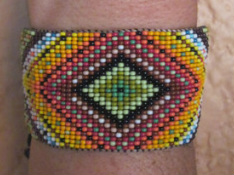 2) Ojo de Dios Another design I am introducing you to is "Ojo de Dios", Eye of God. It was inspired by the culturally rich and colorful artwork of the Huichol Indians of Northern Mexico. "Ojo de Dios" is the protector of children, and is the seeing and power of unknown things. This is Pedro's own contemporary interpretation of "ojo". I love the way the diamond center "eye" knows what one may not know. It's a protector, a guardian, a watcher. Its intricate colors represent all that is the great mystery, the great unknown. Pedro beaded it right on the loom, without using a drawing or making a pattern first. Each time he beads this or other similar designs, he concentrates and uses a meditative technique of counting beads to skillfully create each piece. It's really quite amazing. 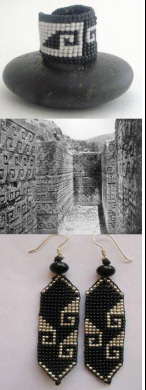 3) The Greca This Greca symbol is found predominately throughout Zapotec regions of Oaxaca, most notably in Mitla, not far from where we live. Mitla is an extraordinary and inspiring place to visit. One just gets captivated by the vast skies and surreal landscapes that surround Mitla. This enigmous and sacred Greca symbol needed to be transformed into bead work. The Greca is a reminder that all forms of life are connected, inseparable, unending. On a side note, if you are ever in Oaxaca, go check out those ruins at Mitla. People generally flock to the more popular, Monte Alban, which is an absolute must see, but you will not be disappointed by Mitla. Let us know what you think about the Grecas if you go and check out how you'll start seeing the symbol everywhere around Oaxaca. picture of Mitla - courtesy of zapotecnativeart.com 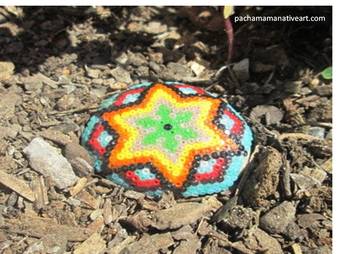 4) Merkaba Here is another one of my favorites. This beaded stone was inspired by sacred geometry, as the Merkaba symbol represents, and mandala-like designs that the Huichol Indians work with. The Merkaba symbol is powerful in that it pulls up the Earth energy from below and pulls down the celestial forces from above, hence forming a harmonious energy balance that's at once up-lifting and grounding. It's also considered a chariot, a vehicle of light and consciousness. Sacred geometry is captured in its shapes and correspond to elements (earth, air, water, fire, ether). See here for more on Merkaba and sacred geometry. They are VERY interesting concepts and demonstrate such intricate designs. The Huichol Indians also use mandala geometry in their work, which is equally inspiring in making pieces such as this beaded stone. I like placing beaded stones like these in our roof garden (and my attempt at making a fairy garden). The grounding element of stones mixed with the beaded mandala designs make for a great balance of the Heavens and Earth among our veges and herbs. Love that! 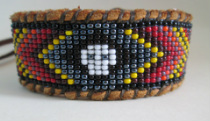 5) Calavera You may have seen and read about calaveras in our last blog. Calavera is the Spanish word for skull. In Mexico, they remind us to live each moment to its fullest, to face one’s mortality with a smile and with courage, and to trust in the immortality of an afterlife. I wanted to include the design here because there are so many ideas about skulls, from pirates to poison, to Halloween, so why not point out why it shows up in Pachamama's work and also what it means for us. So, these are the main designs you see in our work, but there is more I'd like to mention. We have a lot of animal designs on our site. All animals are sacred and each holds its own potentially powerful medicine.They are our friends, guardians and teachers. They offer us their wisdom and beading them into art is a way to honor their them and their gifts. Gemstones are also elements we work with. They have healing properties that can serve and protect its wearer. They are beautiful crystals that are powerful in their own rite and I want to acknowledge them as such.
You can bet that each piece on our site was inspired by something meaningful for us. In that sense, it came into physicality to be a gift for the creator, admirer, and wearer. Each piece was made with intentions of positive and loving thoughts for the wearer and admirer. That you can be sure of. In fact, every time I send one of our pieces to our customers, it is in loving gratitude, and it is our intention for you to enjoy each of our items in peace, prosperity, and good health. Danielle Conte is the writer this of Pachamama Native Art blog. She lives and works with her husband, Pedro Robledo, Beadist, Designer, and Co-Owner of Pachamama Native Art. They live in Oaxaca, Mexico with their son. Danielle can be reached at [email protected] and Pedro can be reached at [email protected]
3 Comments
One Beader's Story: How One Man Found His Way to Beading, As Seen Through The Eyes of a Non-Beader9/6/2013 How does one find her (or in Pedro's case, HIS) way into the colorful and enchanting world of beading? Does she rekindle her passion for making beaded friendship bracelets or pins that she once had in childhood? Maybe he sees a beaded bracelet, bag, or trinket in a store and decides to create a similar piece for his loved one. (Point of caution: Once a beader starts buying beads and beading accessories, there is no turning back. An addition to the house should be added immediately. Best to factor the extra room as a material cost. Trust me! It could be worth your sanity. Just so you know, we don't have an extra room.....but having fun and finding one's creative self IS what it's all about. And this I believe!) Anyway, however you wind up on your beading path, whether you are doing it professionally or as a hobby, I bet you one thing is shared by all beadists: your call into the beading world could not be avoided, nor should be. YOU MUST BEAD!!! HE MUST BEAD!!! All roads lead to beads!! (Yes, I've been dying to say that!) The Sirens play their seductive tunes and any true beader at heart who happens to be passing by at time of the Siren call is lured into the beading world, forever changed and transformed by this unstoppable, creative passion! Okay, it's a bit dramatic, but it's our first blog, so I figure, why not! It's my story, and I am a "non-beader", so I'll tell it like it this. Okay, that's not completely true. I have beaded, too, and I've enjoyed it, but for all purposes, I'll say I'm a "non-beader". Anyway, I wanted to show you how Pedro happened upon on his beading path, so here it goes.... Pedro, Beadist and Designer of Pachamama Native Art, was called into the beautiful world of beading like this... or at least this is how I remember it...or at least this is one version of how I remember it. Pedro's creativity predates this story I tell, but I needed to start somewhere and this is the most relevant place in relation to the work you see on our site.... Many years ago, on a drizzly late autumn (or was it spring?) day, while we were still living in the Boston area, Pedro and I had just finished eating brunch in Coolidge Corner. We headed out of the restaurant, kind of bored, not having any particular plans for the rest of our day. We stumbled upon the store, Ten Thousand Villages, which sells beautiful fair-trade handmade items from all over the world. High upon a shelf was a gorgeous life-size Huichol style beaded deer. Did I say GORGEOUS? Absolutely incredible, amazing, to die-for bead-work! Anyway, the Sirens were singing to Pedro. He was mesmerized. The beading bug bit him; no cure needed. We left the store and went directly to a craft store to buy seed beads and then home to investigate as much as possible about Huichol art and culture. (He investigated, I wondered about this new, kind of expensive hobby that he was getting into. But, just so you know, I've always been truly supportive of Pedro's creative projects...not just because I benefit from them - our wedding rings, my engagement ring, lots of jewelry and cool things, but because I think he's talented and I can honestly see how it's transformed his/our lives for the good. Now, back to the story....) So, that very day, Pedro started beading on objects, following in the Huichol style, but also creating his own designs and patterns. Here are some of his earlier works. You can see how much his work has evolved and transformed. Pedro's Earlier Beading Projects Currently, Pedro mostly beads on the loom, although he definitely still does a lot of beading on objects and gives workshops to help people get started with their beading passions, too. (He's become a Siren himself, calling others to come forth to the beading world). I'll leave the story of how he got started beading on the loom for another day. It was definitely destiny how that happened, too. Isn't funny how life leads you to your destiny?
For now, I'll leave you with this. As a non-beader, I am truly amazed that beaders have patience and ability to put seed beads one-by-one or string-by-string to create scenes and pictures on objects, or to put each seed bead on a loom, or to do all sorts of stitches to create beading masterpieces. Pedro's "mandala" loom work pieces are created by him without a pattern. For me, that is really inspiring. All that counting and concentration. All those similar colors. He says it's meditative. I can definitely see how working with beads IS meditative. That will be the topic of our next blog. Beading as Meditation. But in the meantime, I would like to know: Are you a beader? If so, how did you heed to the Sirens' call? Are you a non-beader who lives with a beader? I'd like to know, do you pick up the seed beads or sweep them away? Comments are welcome! |
Author
Co-owner of Pachamama Native Art, Inc. and writer of this blog. Archives
May 2016
Categories
All
|
Proudly powered by Weebly

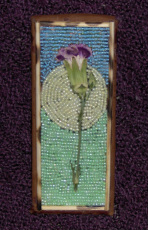
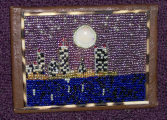
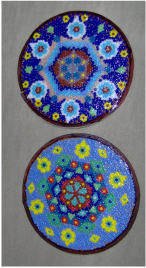
 RSS Feed
RSS Feed